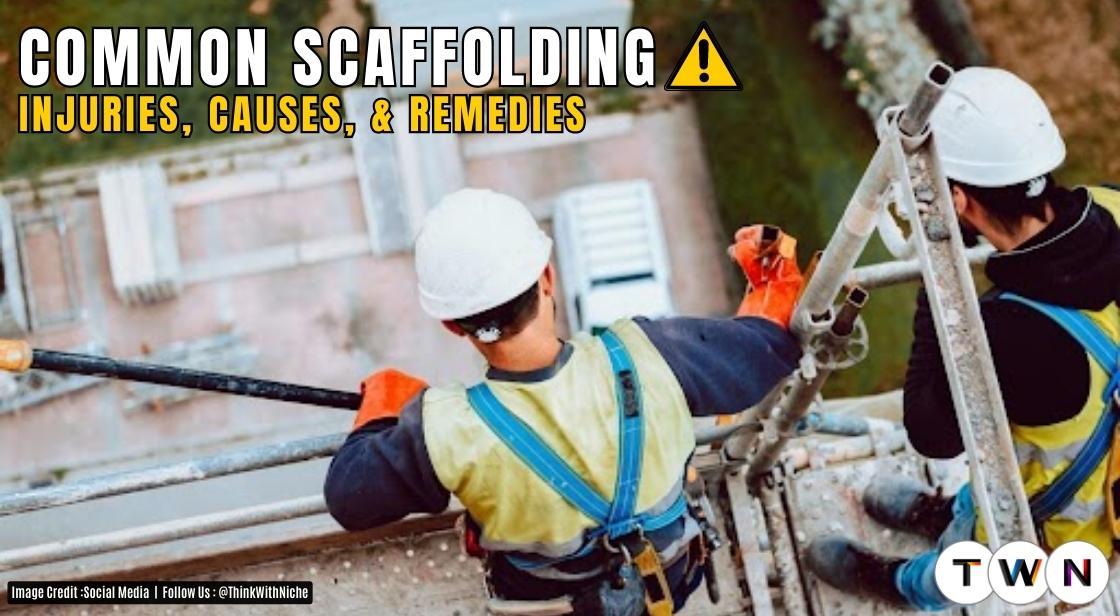5 Common Scaffolding Injuries, Causes, And Available Legal Remedies

Blog Post
Scaffolding is an essential part of any construction project, and while it provides a safe working environment for workers, it can also pose significant risks and hazards. Workers are at risk of suffering from various injuries, and these injuries can range from minor to life-threatening. In this article, we will discuss five common scaffolding injuries, their causes, and available legal remedies.
The most common scaffolding injury falls, which can result from a lack of proper safety equipment, inadequate training, or defective scaffolding. Falls can cause severe injuries, including head injuries, broken bones, and spinal cord injuries. Workers who suffer falls may be entitled to workers' compensation benefits or can file a personal injury lawsuit against the responsible party.
Working on scaffolding can be dangerous. According to the Centers for Disease Control, nearly four and a half million workers in America use scaffolding every day in construction, shipyards, repair yards, marine terminals, and other industries. Unfortunately, these risky work conditions can lead to common scaffolding injuries that might result in high medical costs and even long-term disability. In this blog post, we will discuss five of the most commonly reported scaffolding injuries, the cause of each injury, and available legal remedies for any individuals or organizations that may be found liable for them.
5 Common Scaffolding Injuries, Causes, And Available Legal Remedies
Overview of Scaffolding Injuries and Causes
Working on scaffolding can be a hazardous job. Many injuries occur from falls, but even more, they can be caused by working with and around scaffolding. These injuries may include slips caused by slippery surfaces, falling objects, collapses or shifts of the structure itself, and electrocutions from faulty wiring in the vicinity. In addition to these common causes of scaffolding accidents, instability due to inadequate support and structural design can also lead to severe and debilitating injuries. Unfortunately, with risks this high, it is possible that you could require legal remedies to deal with such an injury. Knowing some typical causes of scaffolding accidents will help you go into such work better prepared for any situation that may arise.
1. The Most Common Types of Scaffolding Injuries
Working at height on scaffolding can be dangerous, and scaffolding injuries remain among the most common types of workplace accidents. Slips, trips, and falls accounted for over 70% of reported cases of scaffold-related accidents, followed by falling objects in excess of 11%. Musculoskeletal disorders were also responsible for over 5% of injuries related to using scaffolding. Employers must take proper steps to ensure their workers’ safety when using this equipment – without it, such risks will only increase.
2. What are the Available Legal Remedies for Scaffolding Injuries
If you have experienced an injury due to negligent scaffolding, it is crucial to understand the legal remedies available to you. Knowing your rights and the potential for legal recourse is key when seeking justice after an injury has occurred. In many cases, a skilled scaffolding injury lawyer will be able to help determine liability and pursue any compensation that may be due. Furthermore, such lawyers can also provide additional resources related to safety on construction sites as well as advice on obtaining proper medical attention following an incident. Taking action after being injured due to scaffolding hazards or any other type of negligence can bring peace of mind and closure while also helping pave the way for a safer future on all worksites across the country.
3. How to Prevent Common Scaffolding Injuries
Working on scaffolding can be dangerous, so it is essential to be aware of some common injuries and how to best prevent them. It is crucial that scaffolding is properly built and secured at all times according to safety standards and regulations. Workers should also wear protective gear such as hard hats, face shields, safety goggles, industrial boots, and reflective vests while ensuring they wear proper-fitting harnesses at higher elevations. Before beginning work, the structure should always be assessed for risks, and any faults should be addressed immediately. Walking on scaffolding requires extra care: workers should maintain a steady grip when moving around it to avoid slips or falls, as well as keep tools and equipment out of walkways. Following these precautions will reduce your chances of suffering an injury while using a scaffold.
Also Read: 5 Rules for Developing a Digital Mindset
4. What You Need to Know About Seeking Compensation for a Scaffolding Injury
If you have been injured due to poor scaffolding practices, knowing your legal rights for seeking compensation for your losses is essential. There are a variety of common scaffolding accidents that occur, including falls from heights, electrocution from power lines, and slips or trips from improper setup. Knowing the causes of these injuries and available remedies can help ensure that you receive the compensation you need and deserve after a scaffolding incident. Understanding what legal options are available in your case can give you clarity on the best choices for pursuing coverage for lost wages, medical bills, and pain and suffering. It is always recommended to speak with an experienced personal injury lawyer who can provide advice tailored to your specific case. Your lawyer will be able to review your claim and guide you through what damages may be recoverable under state law to secure the just compensation you deserve.
5. Final Takeaways on Scaffolding Injuries and Legal Remedies
Working on scaffoldings can be highly dangerous and even lead to injuries. It is essential to address the issue at hand in order to prevent any such scenarios. Common injuries that may result from working on scaffolding include falls, slips, impacts from falling objects, electrocution, and collapse of scaffolds. Causes for these accidents can range from defective equipment, lack of proper safety gear or training, extreme weather conditions, and inadequate maintenance. As such, those injured by negligence related to scaffolding have legal remedies available for them, which include seeking damages for medical costs, pain & suffering, as well as lost wages. Seeking a professional scaffolding injury lawyer would provide victims with the necessary resources to obtain compensation for their injury claims.
Concluding Thoughts
In conclusion, scaffolding injuries can occur from a variety of causes and have the potential to be life-threatening. Keeping safe while working on scaffolds is paramount. It is essential to understand what you are entitled to in the case of a scaffolding injury, should it arise – whether through compensation or a shift to an alternate job role that can accommodate any physical impairments that may result from the injury. Taking an active role in preventing and understanding your rights is critical to staying safe on all kinds of scaffolds so that accidents can be avoided altogether. Ultimately, if you were injured while working on a scaffold, there are many options available such as legal remedies, compensation, and preventive measures that must be considered for the best long-term outcomes.
You May Like
EDITOR’S CHOICE












